8+ Sample Fire Risk Assessment Checklist
-
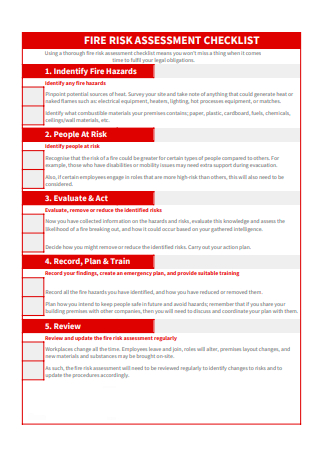
Fire Risk Assessment Checklist Template
download now -
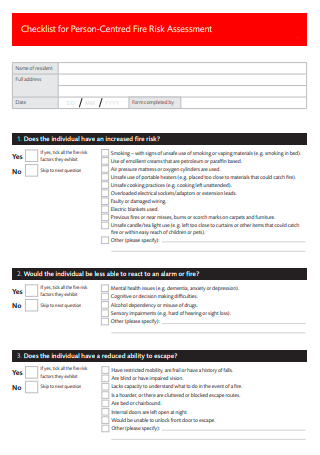
Person Centered Fire Risk Assessment Checklist
download now -
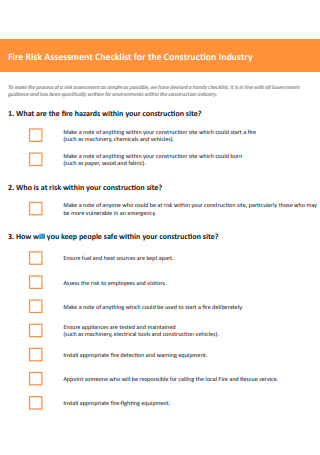
Construction Industry Fire Risk Assessment Checklist
download now -
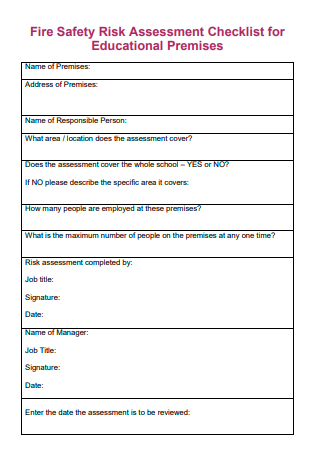
Educational Premises Fire Safety Risk Assessment Checklist
download now -

Fire Risk Assessment Checklist in PDF.
download now -
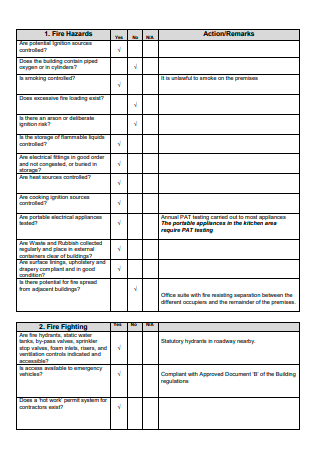
Basic Fire Risk Assessment Checklist
download now -
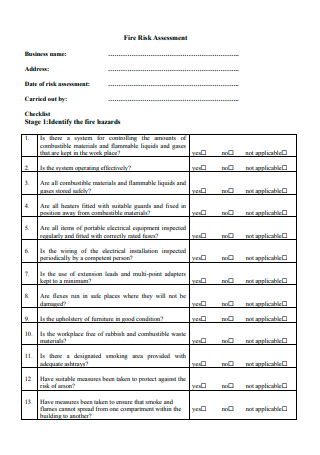
Fire Risk Assessment Checklist Example
download now -
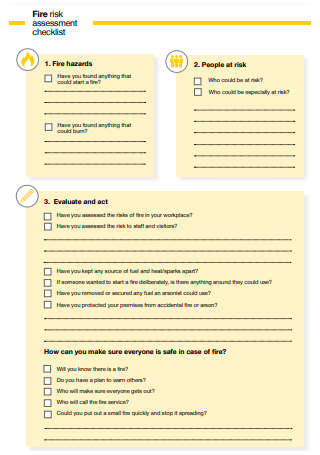
Printable Fire Risk Assessment Checklist
download now -
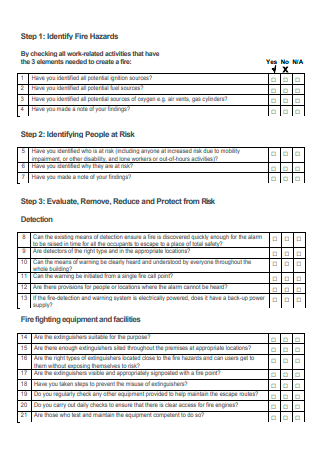
Fire Risk Assessment Safety Checklist
download now
FREE Fire Risk Assessment Checklist s to Download
8+ Sample Fire Risk Assessment Checklist
What is a fire risk assessment checklist?
What are the kinds of fire?
How to Assess Fire Risks
How long does a fire risk assessment take?
Is it necessary to hold a fire risk assessment every year?
What are the key points of a fire risk assessment?
In the US alone, in a five-year period, fire departments have reported an approximate average of 353,100 fires per year. Due to this, there has been an annual average of $7.2 billion for property damage, 2,620 deaths of civilians, and 11,030 injured civilians. With that much casualties, it is given that states and non-government organizations have put out maximum effort in order to strengthen proactive measures to prevent fire, as well as further the development of the accessibility to contact fire departments in cases of fire actually happening. One of these measures is employing risk assessments in establishments, apartment complexes, or homes in general. The use of a fire risk assessment checklist is truly apparent.
What is a fire risk assessment checklist?
When establishing buildings for businesses, for instance, they assign a personal officer responsible to conduct an inspection all around. Their primary task is to identify possible hazards and risks within the place, and it is mandated by law to employ a fire risk assessment as a form of preemptive measures by virtue of the precedence of proliferation of fire incidents. The business is required to keep an official record or document of the discovered findings. This is where the fire risk assessment checklist comes in handy, since it outlines the important concerns to be attended to by the officer, and reminds them of the things he or she should look into and gauge within the location. A fire risk assessment checklist is simply an array of possible risks relating to fire which the officer checks if they coincide with the condition of the place.
What are the kinds of fire?
It is important to know the different kinds of fire, since their distinction also dictates the kind of response that they need. Oxygen, fuel and heat are often referred to as the “fire triangle”, because they are the primary elements that make up flame in and of itself. However, even with such a uniform component origin, they are still able to be divided by different levels, for the variety of locations they may take place in, as well as how they were started. Here, the kinds of fire will be discussed, as well as possible solutions, and their degree of severity and urgency.
How to Assess Fire Risks
As the chosen officer with the responsibility to check the establishment for risks, it is important to know the steps in assessing fire hazards with the use of a fire risk assessment checklist. As the safety checklist guides you in what you should look into around the place, you should also know the process of how to operate in your position, as well as have knowledge on the important things that you should take into consideration, which are highly important to be kept a record of. This is a process to be taken meticulously in order for owners to be able to preempt future scenarios that could endanger lives and the livelihoods of people working for a certain company, for instance. Here is how you assess fire risks.
Step 1: Identifying the fire hazards
Risks pertain to the likelihood of a hazard occurring, while a hazard is something that has the potential to cause harm. To paint a clearer picture, wires, electrical circuits, and broken wires are the hazard, and fire is the risk. It is important to gauge very plausible areas or objects that can evidently cause fire in order for your corporation to know which locations need more protection against fire, because the urgency is better pictured out. Perhaps you could record major sources of heat within the establishment, or anything that can generate heat and flame such as technological devices, areas containing gas tanks, and the like. Areas where materials like paper, wood, and plastic should also be looked into, so the establishment can prepare a water extinguisher nearby for emergency uses.
Step 2: Building Structure
Buildings should be inclusive to people with disabilities, or people who have medical conditions that prevent them from functioning like others. But generally, it is important for buildings to have exit paths that are easy to navigate in, such as ramps, or other kinds of convenient structuring to help people who need it, especially in a state of panic. As the officer, you must point out the need for fire exits, the most convenient places to place them, and which part of the exterior building they could lead to for the safety of the people. It is important to safeguard people and workers ultimately, since they have the highest stake in these situations in comparison to the property itself.
Step 3: Implementation
Since fire risk assessments are ordered by law, it is simple logic to know that your establishment has to comply to the necessary standards and procedures that follow risk assessments. This means that shifts to your building structure may be demanded to be done, or the safeguarding of the areas that have high risks of flammability. This is to ensure that your establishment follows the law itself, reduces the risks of getting fire, and even if it does, at least there is a clear contingency measure to be done should things go south.
Step 4: Recording
After checking the different risks within the area using your fire risk assessment checklist, you must record the solutions that you have come up with to respond to these risks. These recordings are important to serve as precedence for future preparation training. This could be done to orient your workers on what to do in cases of fire. For everyone’s safety, it is important for everyone in the building to be coordinated regarding their knowledge on what to do, where they should evacuate, and where the exit points are in general. It is also a requirement to keep the recording at the end of the day.
Step 5: Reviewing and Revising
Overtime, buildings change regarding the areas of different departments, placement of workers, and the like. Because these things are evolving, your risk assessment should do. This record is done to cater to emergencies and respond to the assurance of safety of people, hence updates may need to be done regularly to ensure that your concerns are still in line with the current condition of the place in and of itself.
How long does a fire risk assessment take?
The duration of a fire risk assessment will vary based on the different sizes of buildings. For larger establishments, it is very likely that it will take a much longer time for the process to finish. But generally speaking, it should take 2-3 hours to finish inspecting a place regarding the risk of fire.
Is it necessary to hold a fire risk assessment every year?
It is mandated by the law for establishments to regularly conduct fire risk assessments due to the volatile nature of this accident. There is no one-size-fits-all policy that dictates the frequency of this assessment, however, as an establishment, you should also be weary of the changes that take place in your building. If there are any restructuring and replacement of departments or specific areas, a reassessment should take place in order to update the record, and keep it and your constituents up to date.
What are the key points of a fire risk assessment?
The key points that the assessment covers should be the risks, the hazards, the catering to the special needs of people, the building structure, the orienting of people who work in that certain building, and the constant update of the record for safety measures.
Being proactive is an important virtue, especially when you hold a hundred, or even a thousand lives. It is important for the well-being of workers to be sustained, and for these people to be prepared for accidents in the first place. Because of panic and fear, it is very likely for people to be irrational and act on impulses, which is why it is strategic for your company to observe proper information dissemination, and before doing that, conducting a fire risk assessment in order for you to know the important places for you to focus on, and improve the probable ways and exit points of people that lead them to safety.
